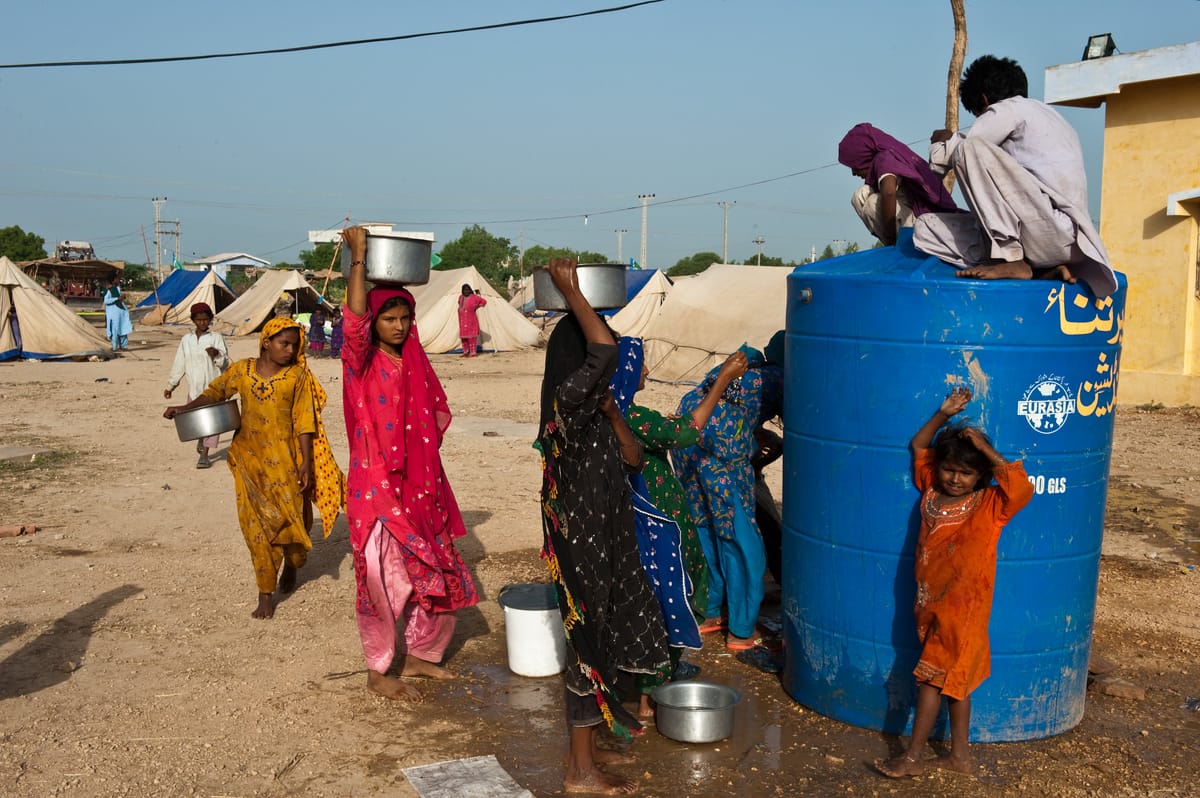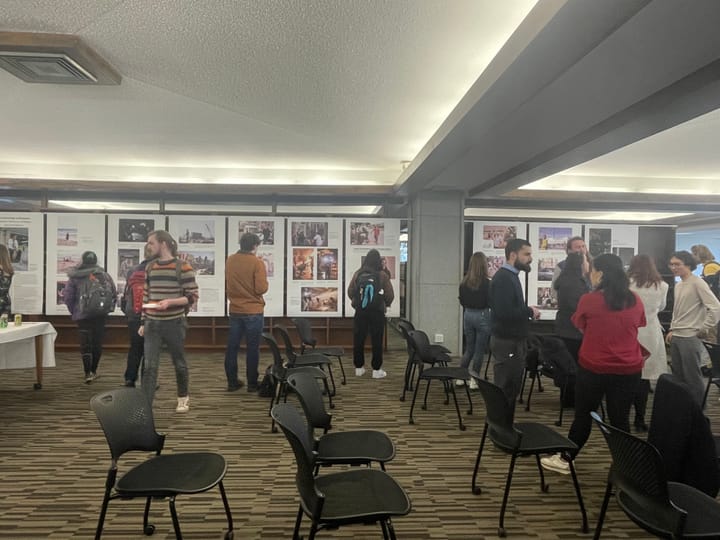Who Are “Climate Refugees”?
Contributing writers Tara Alahakoon ’25 and Mohamed Ramy ’18 discuss the importance of recognizing “climate refugees,” people who have lost their homes and livelihoods due to the increasingly negative effects of climate change.


Imagine that instead of white light streaming through your windows in the morning, bright orange blazes through, a warning glare signaling that you need to pack up your belongings and run. This is what Michelle Teixeira experienced during the 2018 Camp Fire, which leveled Paradise, California, and killed 85 people.
With her home destroyed, where does Michelle now live? And where did the others who resided in 13,792 homes in the area go? The answer is simple: dispersed everywhere but those homes. They became refugees seeking a path to recovery, forced to sleep in parking lots and caravans as they await any form of help. While some were fortunate to have savings, family wealth, and community connections, others were left to fend for themselves because hardly any nation — including the United States — officially recognizes the existence of a “climate refugee.”
Even though the greatest contributors to climate change are in the developed world, the most affected countries are scattered across the developing world. Despite being the country most responsible for harmful emissions, the U.S. asylum system does not protect anyone — U.S. citizen or foreigner — from the dangers of drought, fires, floods, and hurricanes, all of which are occurring at an increasing rate due to climate change. Climate change alters the frequency, duration, and intensity of slow- and sudden-onset events such as flooding from rainfall or droughts resulting from high temperatures. It has been estimated that such events have displaced three times as many people as those fleeing conflict. So what is the world doing about this phenomenon? The answer: next to nothing.
The Paris Agreement is meant to coordinate international efforts to cut greenhouse gas emissions, especially to hold major representatives accountable and to keep this century’s temperature rise below 2°C. This has been one of the most significant initiatives pushing the international community to acknowledge that climate change is a reality that demands immediate action and directly relates to the topic of migration. In one of its preambles, the agreement stipulates that parties should “respect, promote, and consider their respective obligations towards migrants … when taking actions to address climate change.” It also requests, explicitly, that the Executive Committee of the Warsaw International Mechanism create a Task Force on Displacement, as well as compile and recommend comprehensive approaches addressing displacement as a result of the adverse effects of climate change. In the international legal framework, the Paris Agreement is alone in its stipulation to focus on climate change as a factor of displacement.
Therefore, despite the lack of a legal framework focusing solely on climate-induced displacement and recognizing “climate refugees,” international actors are at least aware that climate change is a contributing factor to mass displacements of human life. However, it is imperative that nations’ obligations to persons displaced by climate change are clarified. Otherwise, human rights, including an adequate standard of living, will be compromised. Cross-border displacements necessitate the application of an international legal framework, but without proper international recognition of the phenomena, organizations such as the United Nations Framework Convention on Climate Change (UNFCCC) or High Commission for Refugees (UNHCR) cannot pressure nations to uptake policies safeguarding displaced persons because of climate-related events.
Zeid Ra’ad Hussein, former U.N. High Commissioner for Human Rights, declared that “a continually warming world will be a graveyard for entire ecosystems, entire peoples — and potentially even entire nations.” This statement is not a hyperbole: Tuvalau, a Polynesian island of 10,000 inhabitants in the South Pacific Ocean, is expected to become uninhabitable by 2050. With rising sea levels compromising agricultural activities, Tuvaluans have limited capacity to develop their economy and are forced to depend on nearby New Zealand for employment, foreign aid, and even potential relocation and resettlement.
The Internal Displacement Monitoring Center (IDMC) estimates that sudden-onset events between 2008 and 2016 were 99 percent responsible for the annual displacement of 21 million people. It is important to underline that not all displacement is directly attributable to climate change. It often instead acts as a catalyst that compromises, for example, sources of income, food and water services, ineffective governments, and cultural sites. In other words, significant alterations in the functioning of the community interact with these vulnerable conditions, leading to effects that, aggregated, force one to leave home.
But in instances where displacement is the result of exacerbated climate-related hazards, individuals cannot seek protection under the 1951 Refugee Convention, which only extends to those who have a well-founded fear of persecution because of religion, race, nationality, or membership to a group of particular political opinion or social affiliation. Without an international agreement beholding national governments to provide adequate support, the international legal regime risks people in coastal and low-lying areas like Tuvalau being rendered stateless and without basic human rights.
Even within the United States and its territories — despite its status as a resourced nation — millions of people are projected to be displaced by climate change. The 2021 Atlantic hurricane season made shorelines nearly uninhabitable, followed by flash floods in New York City and the greater Northeast; Puerto Rico faces increased risk of coastal and inland flooding as sea levels rise; and wildfires have set California ablaze. Moreover, the U.S.-Mexico Border Patrol’s notorious culture of impunity allows incoming climate migrants to face routine acts of brutality in addition to the obstruction of humanitarian aid and the criminalization of accessing life-saving resources. As opposed to subsistence farmers and other rural communities around the globe, most Americans’ monetary wealth has distanced them from their environmental sources of livelihood and cushioned them from the blows of climate change. As a result, while the word “refugee” alone has long been stigmatized in the U.S., “climate refugee” is an abnormally foreign concept. Yet as climate change reaches new heights, we have begun to understand some circumstances of displacement for the first time. Americans themselves are finally beginning to wonder: where will we go?
Only widespread acknowledgment of the realities of climate change and climate-induced displacement can develop public understanding of the crisis and explicitly define the rights and protection measures of “climate refugees.” Climate change and its consequences are currently underacknowledged on campus. We encourage the Amherst community to reflect upon this and incorporate these terms into regular academic discourse: faculty should include this topic in their courses where appropriate — such as in those of anthropology, sociology, and political science — and we suggest that the administration consider bringing speakers to campus who are informed on the matter. Amherst College should lead The Five College Consortium in this implementation.
To aid climate refugees, the Amherst community needs to work towards fostering a welcoming social and intellectual environment in which migration is recognized as an opportunity for the enrichment of our collective culture. Debate Society should present such issues to thread these ideas into discussion. Courses, publications, and clubs involving writing and art — especially those with a focus on human rights and migration — must incorporate the climate crisis to spark this intersectional thought and conversation that has become essential as preparation for our future. Additionally, members can support organizations such as Welcome Home Refugee Resettlement Program, a diverse coalition of parties that helps refugees in Hampshire County to build and adjust to their new lives.
We must understand that our legislation is outdated — our world is evolving more rapidly than policy is catching up. There needs to be greater concern for “climate refugees” and a plausible legal framework that integrates migration as an adaptation strategy. It is imperative that we each take the initiative to independently critically assess the needs of people due to the circumstances of our world, instead of waiting for legislation to first create a system of obligation within which we are compelled to act. Denial of the climate crisis inflicts on communities a form of “slow violence”: an attack so slow that it is often not perceived as real, so drawn out and complex that it is difficult to connect the harm with the cause. We must break the cycle to avoid becoming increasingly trapped — climate refugees in a state of liminality, and everyone else in circular conversations.



Comments ()